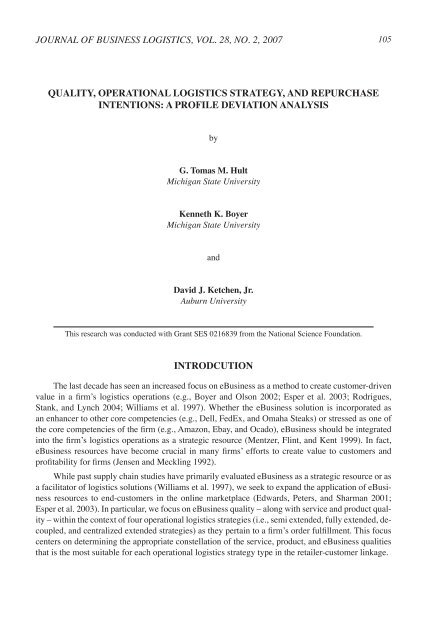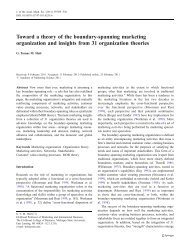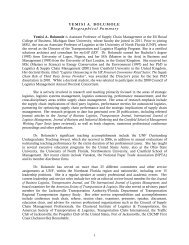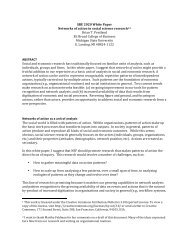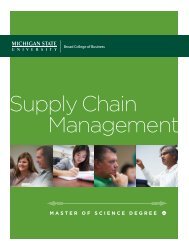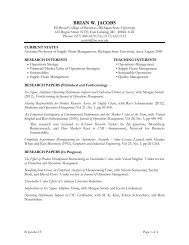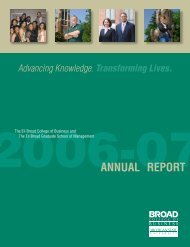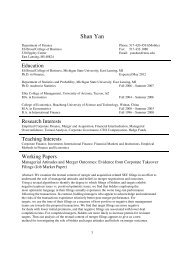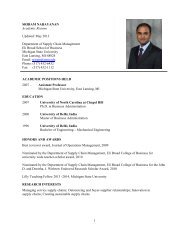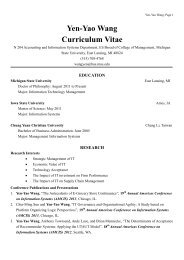Journal of Business logistics, Vol. 28, no. 2, 2007 ... - Global Initiatives
Journal of Business logistics, Vol. 28, no. 2, 2007 ... - Global Initiatives
Journal of Business logistics, Vol. 28, no. 2, 2007 ... - Global Initiatives
Create successful ePaper yourself
Turn your PDF publications into a flip-book with our unique Google optimized e-Paper software.
<strong>Journal</strong> <strong>of</strong> <strong>Business</strong> Logistics, <strong>Vol</strong>. <strong>28</strong>, No. 2, <strong>2007</strong> 105QUALITY, OPERATIONAL LOGISTICS STRATEGY, AND REPURCHASEINTENTIONS: A PROFILE DEVIATION ANALYSISbyG. Tomas M. HultMichigan State UniversityKenneth K. BoyerMichigan State UniversityandDavid J. Ketchen, Jr.Auburn UniversityThis research was conducted with Grant SES 0216839 from the National Science Foundation.INTRODCUTIONThe last decade has seen an increased focus on e<strong>Business</strong> as a method to create customer-drivenvalue in a firm’s <strong>logistics</strong> operations (e.g., Boyer and Olson 2002; Esper et al. 2003; Rodrigues,Stank, and Lynch 2004; Williams et al. 1997). Whether the e<strong>Business</strong> solution is incorporated asan enhancer to other core competencies (e.g., Dell, FedEx, and Omaha Steaks) or stressed as one <strong>of</strong>the core competencies <strong>of</strong> the firm (e.g., Amazon, Ebay, and Ocado), e<strong>Business</strong> should be integratedinto the firm’s <strong>logistics</strong> operations as a strategic resource (Mentzer, Flint, and Kent 1999). In fact,e<strong>Business</strong> resources have become crucial in many firms’ efforts to create value to customers andpr<strong>of</strong>itability for firms (Jensen and Meckling 1992).While past supply chain studies have primarily evaluated e<strong>Business</strong> as a strategic resource or asa facilitator <strong>of</strong> <strong>logistics</strong> solutions (Williams et al. 1997), we seek to expand the application <strong>of</strong> e<strong>Business</strong>resources to end-customers in the online marketplace (Edwards, Peters, and Sharman 2001;Esper et al. 2003). In particular, we focus on e<strong>Business</strong> quality – along with service and product quality– within the context <strong>of</strong> four operational <strong>logistics</strong> strategies (i.e., semi extended, fully extended, decoupled,and centralized extended strategies) as they pertain to a firm’s order fulfillment. This focuscenters on determining the appropriate constellation <strong>of</strong> the service, product, and e<strong>Business</strong> qualitiesthat is the most suitable for each operational <strong>logistics</strong> strategy type in the retailer-customer linkage.
106 hult, boyer, and ketchen, Jr.The focus on the retailer-customer linkage is both theoretically interesting and practically valuablebecause <strong>of</strong> its increasingly important role in affecting firm outcomes (cf. Daugherty, Stank, andEllinger 1998; Mentzer 1993; Niraj, Gupta, and Narasimhan 2001). In addition, the retailer-customerlinkage within supply chains (Handfield and Nichols 2003) presents an opportunity for e<strong>Business</strong>initiatives to create unique advantages vis-à-vis competitors (Carter and Narasimhan 1996). In particular,the “last mile <strong>of</strong> the supply chain” (i.e., the retailer-customer linkage in the online market)represents perhaps the most critical part <strong>of</strong> the chain to manage (Boyer, Frolich, and Hult 2004). Afirm’s ability to create value for customers in the last mile <strong>of</strong> the chain can be severely impeded byhow operational <strong>logistics</strong> strategies are implemented (e.g., Venkatesh, Kohli, and Zaltman 1995). Ourfocus is on the implementation <strong>of</strong> customer-driven quality elements (service, product, and e<strong>Business</strong>quality), which quality elements to emphasize for each <strong>logistics</strong> strategy, and the connection to customers’repurchase intentions from the online grocery firm.As such, in this study we examine a model <strong>of</strong> customer-driven quality elements and their linkto customers’ behavioral (repurchase) intentions within the online grocery industry. The theoreticalfoundation is composed <strong>of</strong> strategic choice theory (Child 1972), configuration theory (Doty, Glick,and Huber 1993; Miller 1997), and research from the Nordic School <strong>of</strong> Services Management (Grönroos1984; Grönroos and Gummesson 1985). Specifically, these three streams <strong>of</strong> research providedthe guide to identifying the three quality constructs (service-, product-, and e<strong>Business</strong>-quality) thatare analyzed as value creation elements for firms adopting different operational <strong>logistics</strong> strategies(Dresner and Xu 1995; Sterling and Lambert 1987; Wisner 2003). Based on the services marketingand services operations literature, the outcome examined is a customer’s repurchase intention froman online grocer (Esper et al. 2003).To provide managerially relevant implications, we studied the effect <strong>of</strong> these three quality constructson customers’ repurchase intentions among the customers <strong>of</strong> firms that have adopted vastlydifferent operational <strong>logistics</strong> strategies (semi extended, fully extended, de-coupled, and centralizedextended strategies). While each <strong>of</strong> these <strong>logistics</strong> strategies have proven viable and can result insuperior performance (Boyer, Frolich, and Hult 2004), each strategy is likely to need to be nurturedby a different emphasis <strong>of</strong> the three quality elements. Below, we provide a theoretical integration<strong>of</strong> the relevant literature streams. This section is followed by a discussion <strong>of</strong> the methods (data collection,samples, and measures), analysis (e.g., pr<strong>of</strong>ile deviation analysis), results (the regressionanalysis including control variables and the pr<strong>of</strong>ile-deviation criterion along with multiple tests toverify the correctness <strong>of</strong> the results), and a discussion <strong>of</strong> the implications <strong>of</strong> the study as well as thefuture avenues for research.THEORETICAL INTEGRATIONWithin the marketing, <strong>logistics</strong>, and supply chain literatures, three quality characteristics (service-,product-, and e<strong>Business</strong>-quality) have been suggested to be critical antecedents <strong>of</strong> customers’repurchase intentions. Service quality is defined as “the consumer’s overall impression <strong>of</strong> the relativeinferiority/superiority <strong>of</strong> the organization and its services” (Bitner and Hubbert 1994, p. 77; Mentzer,Flint, and Hult 2001). Product quality is defined as “the consumer’s [subjective] judgment about aproduct’s overall excellence or superiority” (Zeithaml 1988, p. 3). e<strong>Business</strong> quality, in this study, isdefined as aspects <strong>of</strong> quality that are critically affected by taking orders online (Agarwal and Prasad
<strong>Journal</strong> <strong>of</strong> <strong>Business</strong> Logistics, <strong>Vol</strong>. <strong>28</strong>, No. 2, <strong>2007</strong> 1071999; Boyer and Olson 2002). While service and product quality are established concepts, e<strong>Business</strong>quality is a relatively new phe<strong>no</strong>me<strong>no</strong>n that can be attributed to the Internet era. As such, companiessuch as Amazon.com, Dell, and Tesco thrive partly because <strong>of</strong> their ability to <strong>of</strong>fer customers an onlineinterface to ordering their products that is user friendly. In fact, user friendly tech<strong>no</strong>logy is <strong>of</strong>tenseen as a core competency by customers and firms alike. This new dimension <strong>of</strong> quality – labelede<strong>Business</strong> quality in our research – has assumed a place alongside service and product quality in affectingcustomer repurchase intentions.One approach to understanding how the concepts <strong>of</strong> service-, product-, and e<strong>Business</strong>-quality,operational <strong>logistics</strong> strategy, and repurchase intentions relate to each other is to search for linearrelationships that apply across all members <strong>of</strong> a sample. A linear understanding <strong>of</strong> relationships iscommonly used in social science studies, and has been applied regularly in quality oriented studies.However, a key disadvantage to this approach is that important relationships may be masked bydata aggregation (Miller 1987). For example, if emphasizing service quality greatly enhances somecustomers’ intentions while having a small effect on others, these effects may “average out” to amodest level in an aggregate analysis. The result is that <strong>no</strong> firm’s situation is depicted as accuratelyas it could be.To <strong>of</strong>fset this potential limitation and to advance the literature both managerially and methodologically,we adopt a focus on configurations – the simultaneous consideration <strong>of</strong> multiple interwovenfactors (Miller 1997). In our study, a configuration refers to a constellation <strong>of</strong> the threequality elements and operational <strong>logistics</strong> strategy (Meyer, Tsui, and Hinings 1993). Configurationaltheory contends that the closer a firm matches an “ideal constellation,” the better its outcomes. Morebroadly, a focus on such configurations avoids the aggregation problem identified by Miller (1987).As such, configuration theory allows for a more managerially relevant assessment <strong>of</strong> the preferredmakeup <strong>of</strong> service-, product-, and e<strong>Business</strong>- quality elements for specific operational <strong>logistics</strong> strategiesthan can be analyzed via linear modeling (cf. Vorhies and Morgan 2003).When fit among multiple elements is considered simultaneously and the effects on outcomesare examined, as in our study, configuration should be conceptualized and measured via pr<strong>of</strong>ile deviationanalysis (Doty, Glick, and Huber 1993; Venkatraman 1990; Vorhies and Morgan 2003). Thisanalysis assesses the fit between the three quality elements and strategy as the degree to which thequality elements <strong>of</strong> a supply chain differ from those <strong>of</strong> an “ideal” pr<strong>of</strong>ile for implementing a specificoperational <strong>logistics</strong> strategy (Vorhies and Morgan 2003; Zajac, Kraatz, and Bresser 2000). Below,we describe the conceptual background for the components <strong>of</strong> the pr<strong>of</strong>iles (quality and operational<strong>logistics</strong> strategy). We then develop hypotheses relating the pr<strong>of</strong>iles and our outcome <strong>of</strong> interest (i.e.,a customer’s repurchase intention).Configurations <strong>of</strong> Quality and Operational Logistics StrategyIn light <strong>of</strong> configuration theory (Doty, Glick, and Huber 1993), coupled with guidance fromstrategic choice theory (Child 1972) and the quality literatures, two major constructs are relevant tounderstanding and assessing quality-based fit with strategy: operational <strong>logistics</strong> strategy types andquality-based supply chain characteristics including service-, product-, and e<strong>Business</strong>-quality. “Strategictype pertains to the planned patterns <strong>of</strong> organizational adaptation to the market through which abusiness seeks to achieve its strategic goals” (Vorhies and Morgan 2003, p. 102; cf. Conant, Mokwa,and Varadarajan 1990; Matsu<strong>no</strong> and Mentzer 2000).
108 hult, boyer, and ketchen, Jr.Strategic choice theory argues that the major decisions managers make for their firms have significantimplications for the firms’ outcomes (Child 1972). In that sense, strategic choice theory contrastswith other theories such as population ecology and institutional theory where external forcesare viewed as the dominant drivers <strong>of</strong> firm outcomes. Using strategic choice theory as the theoreticalfoundation, we identified four operationally based <strong>logistics</strong> strategies as appropriate in an organization’sefforts to extend their supply chains toward the customer: centralized extended strategy, fullyextended strategy, de-coupled strategy, and semi-extended strategy (Boyer, Frolich, and Hult 2004).As shown in Figure 1 and Table 1, order fulfillment location (store-based vs. distribution centerbased)and method <strong>of</strong> delivery to customer (direct vs. indirect) are the two key dimensions that differentiateamong the four strategies. The resultant strategies represent four different approaches to afundamental question: to what extent and how will a firm extend its supply chain to reach customers?Relative to the other approaches, a fully extended strategy maximizes activities close to the customer.Specifically, this strategy involves a firm fulfilling orders at the store level and then delivering goodsdirectly to customers. For example, Tesco.com, the online segment <strong>of</strong> British retailer Tesco, picksorders from individual stores and takes them to private homes. Their online business accounted forover $1.25 billion in revenues in 2005, but it represents just 2.6% <strong>of</strong> Tesco’s total sales. Using a fullyextended strategy enables Tesco to minimize capital investment in what is currently a niche marketfor the firm. This approach also <strong>of</strong>fers a high level <strong>of</strong> customer convenience, but delivery costs arerelatively high and picking efficiency is low.Firms following a centralized extended strategy fulfill orders through distribution centers (“centralized”)and then deliver goods directly to customers (“extended”). One example is Office Depot,which delivered over $3 billion in <strong>of</strong>fice supplies directly from warehouses to customers’ <strong>of</strong>fices andhomes in 2004. Firms following a centralized extended strategy face trade-<strong>of</strong>fs. The strategy enablesfirms to enjoy high picking efficiency and provide high levels <strong>of</strong> customer convenience, but deliverycosts and capital investments are relatively high. In Office Depot’s case, however, the size <strong>of</strong> thefirm’s home delivery business accrues eco<strong>no</strong>mies <strong>of</strong> scale that mitigate some <strong>of</strong> these costs.When following a de-coupled strategy, a firm fulfills orders at a distribution center and thenrelies on a delivery firm (such as DHL, Federal Express, or UPS) to send orders to customers. Suchan “arm’s length” approach entails relatively large fixed investments initially (for warehouses), butminimizes the variable costs involved in actual deliveries. This strategy has helped Dell becomethe dominant player in the personal computer industry. Other examples <strong>of</strong> firms using a de-coupledstrategy include Amazon, NetFlix, and Caremark.A semi-extended strategy involves fulfilling orders at the store-level. Customers place ordersover the Internet and then pick up their goods at a retail store. This approach requires little capitalinvestment and delivery costs are also minimal. However, picking efficiency is limited and some customersconsider visiting stores to be inconvenient. Examples <strong>of</strong> firms using a semi-extended strategyinclude REI, Circuit City, Rite-Aid, and Lowes Food.
110 hult, boyer, and ketchen, Jr.FIGURE 1OPERATIONAL LOGISTICS STRATEGIES FOR EXTENDING THE SUPPLY CHAINStore-basedOrder FulfillmentDistribution CenterLowLowIndirectSemiExtendedStrategyDe-CoupledStrategyDeliveryDeliveryCostCustomerConvenienceDirectFullyExtendedStrategyCentralizedExtendedStrategyHighHighLowLowPickingEfficiencyCapitalInvestmentHighHighHypothesis DevelopmentAs shown in Figure 2, using the logic established by Vorhies and Morgan (2003), we posit linkagesamong quality, operational <strong>logistics</strong> strategy, and customers’ repurchase intentions. To specifyand test the relationships outlined in Figure 2, we draw on the insights <strong>of</strong> Doty, Glick, and Huber(1993) and Venkatraman (1990) who suggest that when fit among multiple variables is consideredsimultaneously (as in the holistic study <strong>of</strong> the relationship between quality characteristics and operational<strong>logistics</strong> strategy types) and links to criterion variables are assessed (i.e., repurchase intentions),fit should be conceptualized and assessed via pr<strong>of</strong>ile deviation analysis (cf. Vorhies and Morgan2003). Pr<strong>of</strong>ile deviation analysis views fit as the degree to which a particular case (a customer,in our study) matches an “ideal” pr<strong>of</strong>ile (an optimal standing within a dataset) (Venkatraman 1990;Zajac, Kraatz, and Bresser 2000).34
<strong>Journal</strong> <strong>of</strong> <strong>Business</strong> Logistics, <strong>Vol</strong>. <strong>28</strong>, No. 2, <strong>2007</strong> 111FIGURE 2A MODEL OF CUSTOMERS’ BEHAVIORAL REPURCHASE INTENTIONSQuality Pr<strong>of</strong>ile Characteristics• Service Quality• Product Quality• e<strong>Business</strong> QualityLogistics Strategies• Semi Extended Strategy• Fully Extended Strategy• De-Coupled Strategy• Centralized Extended StrategyQuality Pr<strong>of</strong>ile Fitwith Strategic TypeDeviation from an idealquality pr<strong>of</strong>ile that producessuperior performance byarranging resources in waysthat enable <strong>logistics</strong> strategyimplementation.Customers’BehavioralRepurchaseIntentionsThe expectation that product-, service-, and e<strong>Business</strong>-quality have a linkage with repurchaseintentions among online grocery firms can be traced to the theoretical grounding <strong>of</strong>fered by theNordic School <strong>of</strong> Service Management (NSSM) (Grönroos 1982, 1984; Grönroos and Gummesson1985). The NSSM perspective lends itself well to online business encounters (such as online groceryshopping) signified by a considerable product component (Grönroos 1990). What happens in theseonline encounters will have a critical impact on the perceived service, product, and e<strong>Business</strong> qualitiesas well as customers’ future behavioral intentions. Customers’ behavioral repurchase intentions“can be viewed as indicators that signal whether customers will remain with or defect from the company”(Zeithaml, Berry, and Parasuraman 1996, p. 33).35Based on the NSSM school <strong>of</strong> thought, customers evaluate the online business encounter alongtwo dimensions, a technical and a functional dimension (e.g., Grönroos 1984). Related to the technicaldimension, what customers receive in their interactions with the firm is important to theirevaluation (e.g., Zeithaml 1988). This is <strong>of</strong>ten thought <strong>of</strong> as the quality <strong>of</strong> the product delivered (i.e.,the technical quality). It is what the customer is left with when the production process and onlineinteractions are over. Additionally, product quality has been found to have an impact on customer’sbehavioral intentions (Normann 1984).However, the technical dimension will <strong>no</strong>t account for a consumer’s total evaluation <strong>of</strong> the onlinegrocery encounter. Customers will also be influenced by the way in which the product – the outcomeor end result <strong>of</strong> the encounter – is delivered to them. As such, customers are influenced by how theyreceive the products. This portion <strong>of</strong> the online grocery encounter is referred to as functional qualitywithin the NSSM framework. It incorporates the more subjective service and e<strong>Business</strong> qualities associatedwith the encounter (cf. Grönroos 1982, 1990). Based on the NSSM school <strong>of</strong> thought (e.g.,Grönroos 1990) coupled with subsequent research on service and e<strong>Business</strong> qualities, both quality
112 hult, boyer, and ketchen, Jr.attributes are linked with customers’ behavioral intentions (Boulding, Kalra, and Staelin 1999; Parasuraman,Zeithaml, and Malhotra 2004; Zeithaml, Berry, and Parasuraman 1996). In fact, the <strong>no</strong>tionthat customers prefer greater service and e<strong>Business</strong> qualities, in addition to product quality, is ratherintuitive, especially if price and other tangible and intangible elements are held constant.In summary, we expect that the outcomes involving online grocery firms (in our case, customers’repurchase intentions) will be greater when their quality pr<strong>of</strong>iles are similar to those <strong>of</strong> theperformance-maximizing ideal pr<strong>of</strong>ile <strong>of</strong> a certain operational <strong>logistics</strong> strategy type (as illustrated inFigure 2) (cf. Vorhies and Morgan 2003). As such, we hypothesize that:H 1: The more similar the quality pr<strong>of</strong>ile <strong>of</strong> an online grocery firm pursuing a semi-extendedstrategy is to that <strong>of</strong> the ideal pr<strong>of</strong>ile for a semi-extended strategy type, the greater therepurchase intentions <strong>of</strong> the firm customers.H 2: The more similar the quality pr<strong>of</strong>ile <strong>of</strong> an online grocery firm pursuing a fully extendedstrategy is to that <strong>of</strong> the ideal pr<strong>of</strong>ile for a fully extended strategy type, the greater therepurchase intentions <strong>of</strong> the firm customers.H 3: The more similar the quality pr<strong>of</strong>ile <strong>of</strong> an online grocery firm pursuing a de-coupledstrategy is to that <strong>of</strong> the ideal pr<strong>of</strong>ile for a de-coupled strategy type, the greater therepurchase intentions <strong>of</strong> the firm customers.H 4: The more similar the quality pr<strong>of</strong>ile <strong>of</strong> an online grocery firm pursuing a centralizedextended strategy is to that <strong>of</strong> the ideal pr<strong>of</strong>ile for a centralized extended strategy type, thegreater the repurchase intentions <strong>of</strong> the firm customers.METHODData Collection and SamplesThe overall sample consisted <strong>of</strong> customers <strong>of</strong> four different online/home delivery grocers.Online/home delivery grocers present an interesting area <strong>of</strong> application for the study <strong>of</strong> operational<strong>logistics</strong> strategy types and quality issues (service, product, and e<strong>Business</strong>) because many such firmshave struggled (e.g., Webvan), suggesting that much remains unk<strong>no</strong>wn about this area. In addition,operational <strong>logistics</strong> strategy as a research focus is increasing in the <strong>logistics</strong> literature (Clinton andCloss 1997; Wisner 2003).The four strategies we discuss are based on inductive insights generated through our preliminaryfieldwork coupled with actual order fulfillment and delivery methods used by the firms in the sample.The fieldwork involved a series <strong>of</strong> interviews with industry experts and participant observation activitieswithin several firms (e.g., visiting firm locations, warehouses, transportation operations). Oncewe identified the four strategies, we sought out one firm that pursues each strategy to participate inthe study. Executives from each firm then verified the classification <strong>of</strong> their firm within the selectedstrategy type (between three to fifteen executives per firm verified the strategy classification). Collectively,this method ensured the correct classification <strong>of</strong> each firm within the appropriate strategytype. For example, if a firm fills orders by picking from a distribution center and the customers pick
<strong>Journal</strong> <strong>of</strong> <strong>Business</strong> Logistics, <strong>Vol</strong>. <strong>28</strong>, No. 2, <strong>2007</strong> 113up the “assembled basket” <strong>of</strong> products from the DC or a<strong>no</strong>ther location, we classify the strategy as“de-coupled strategy.” The same logic applies to the other strategies – they are based on actual orderfulfillment and actual delivery methods, <strong>no</strong>t perceptions by the researchers or executives.Each quadrant in Figure 1 is represented by the customers <strong>of</strong> one firm. All four firms weregenerous with their time and allowing us access to their customers, but prefer <strong>no</strong>t to be identified byname given the competitive nature <strong>of</strong> the home delivery grocery business. While we can<strong>no</strong>t includeindividual sales and financial characteristics for sensitivity reasons, collectively the firms had annualonline/home delivery sales <strong>of</strong> more than $150 million in 2003 and an aggregate customer base <strong>of</strong>more than 100,000 customers who purchase at least once per month. The people in our final sampleaccount for over 34,000 purchases and $4 million total in home delivery sales over the length <strong>of</strong> theirrelationship with the Internet grocer. The general survey data collection principles recommendedby Dillman (2000) were followed. All measures in the study were pre-tested via discussion withnumerous managers at the participating companies as well as executives from other online grocers.Suggestions for wording and presentation were used to improve each <strong>of</strong> the measures prior todata collection.Semi extendedCustomers <strong>of</strong> this grocer were contacted by email and asked to fill out an online survey. Onefree delivery (a $4.95 value) was <strong>of</strong>fered to customers as an incentive to complete the survey andcustomers were sent a reminder email one week after the first email if they had <strong>no</strong>t yet filled out thesurvey. A total <strong>of</strong> 1,159 customers were contacted and 396 responses were received for a responserate <strong>of</strong> 34.2%.Fully extendedThis grocer was <strong>no</strong>t comfortable providing us with any contact or past ordering information onany customers despite our standard and repeated assurances that all information would be held incomplete confidentiality. Thus, to obtain customer responses related to the fully extended grocer, thisgrocer posted a link on the checkout page for orders inviting customers to “opt-in” and fill out thesurvey. No incentive for participation was <strong>of</strong>fered. A total <strong>of</strong> 10,418 unique customers (14,959 totalorders) were placed over a two-week period and we received 898 survey responses (8.5%).De-coupledCustomers <strong>of</strong> this grocer were contacted by email and asked to fill out an online survey. Thegrocer provided baseball hats with the grocer’s logo as an incentive to complete the survey – thechoice <strong>of</strong> incentives was partly driven by the desire to build the company’s brand given a lack <strong>of</strong>brick and mortar stores. A total <strong>of</strong> 2,000 customers were contacted and 461 responses were receivedfor a response rate <strong>of</strong> 23.0%.Centralized extendedCustomers <strong>of</strong> this grocer were contacted by email and asked to fill out an online survey. Thegrocer provided 20 pairs <strong>of</strong> movie tickets to be raffled <strong>of</strong>f to customers participating in the survey. Areminder email was sent one week after the first if customers had <strong>no</strong>t yet filled out the survey. A total<strong>of</strong> 2,500 customers were contacted and 691 responses were received for a response rate <strong>of</strong> 27.6%.
114 hult, boyer, and ketchen, Jr.Non-response biasThe extrapolation procedure suggested by Armstrong and Overton (1977) was used to assesspotential <strong>no</strong>n-response bias. When assessing the first quartile versus the last quartile <strong>of</strong> the respondentsin each sample group (semi extended, fully extended, de-coupled, and centralized extendedstrategies), we found <strong>no</strong> significant differences on any <strong>of</strong> the seven summated measures in the survey(i.e., service quality, product quality, e<strong>Business</strong>-quality, attitude toward Internet ordering, online accessibility,sacrifice, and behavioral intentions). Thus, our inference is that the data are free fromsystematic difference bias. Thus, <strong>no</strong>n-response bias does <strong>no</strong>t appear to be an inhibiting factor inanalyzing the hypothesized relationships.Statistical powerFor each operational <strong>logistics</strong> strategy type, we conducted power analysis per the guidelines<strong>of</strong> Cohen, Cohen, West, and Aiken (2003) to determine the probability <strong>of</strong> finding the sample R2 tobe greater than zero with α = 0.01. We achieved excellent statistical power (β > 0.99, p < 0.01) ineach scenario.MeasuresThe measures used in this study are included in the Appendix. Three categories <strong>of</strong> measureswere employed to assess the fit <strong>of</strong> the service, product, and e<strong>Business</strong> quality-pr<strong>of</strong>ile with operational<strong>logistics</strong> strategy types and their effects on customer repurchase intentions: (1) pr<strong>of</strong>ile measures (i.e.,service-, product-, and e<strong>Business</strong>-quality measures), (2) customers’ behavioral repurchase intentions,and (3) control variables (i.e., attitude toward Internet ordering, online accessibility, and sacrifice).Quality pr<strong>of</strong>ile measuresThree measures were used to develop the ideal pr<strong>of</strong>iles for each strategy type: service quality,product quality, and e<strong>Business</strong> quality. Service quality was measured via ten items based on Parasuraman,Zeithaml, and Berry’s (1985) ten original dimensions <strong>of</strong> service quality (reliability, understanding,responsiveness, competence, security, courtesy, access, tangibles, credibility, and communication)(cf. Gotlieb, Grewal, and Brown 1994; Mentzer, Flint, and Hult 2001). Product qualitywas measured via six items adapted from works by Brucks, Zeithaml, and Naylor (2000), Carsky,Dickson, and Canedy (1998), and Garvin (1987). e<strong>Business</strong> quality was measured via seven itemsadapted from Agarwal and Prasad (1999) and Boyer and Olson (2002).Repurchase intentionsGiven the customer focus <strong>of</strong> our study, we opted to use customers’ behavioral intentions as theoutcome variable. This is consistent with previous studies on <strong>logistics</strong>-based online retail phe<strong>no</strong>mena(Esper et al. 2003; Keller et al. 2002). Zeithaml, Berry, and Parasuraman (1996) develop an argumentthat positive behavioral intentions are reflected in a firm’s ability to get its customers to: (1) say positivethings about them; (2) recommend them to other consumers; (3) remain loyal to them; (4) spendmore with the company; and (5) pay price premiums. Similar to Cronin, Brady, and Hult (2000), weused four items to operationalize customers’ behavioral intentions that are similar to the domains assessedin the first four <strong>of</strong> these five outcomes (cf. Samiee and Anckar 1998). It is important to <strong>no</strong>tethat although we do <strong>no</strong>t have access to objective performance data, we found that the summated
116 hult, boyer, and ketchen, Jr.TABLE 2CORRELATIONS AND SHARED VARIANCES (N = 2,440)SQ PQ IQ ATT OAA SAC BISQ – 0.24 0.10 0.02 0.08 0.08 0.18PQ 0.49 – 0.16 0.04 0.10 0.20 0.<strong>28</strong>EQ 0.32 0.40 – 0.07 0.35 0.27 0.14ATT 0.14 0.21 0.26 – 0.05 0.10 0.07OA 0.<strong>28</strong> 0.32 0.59 0.23 – 0.16 0.08SAC 0.29 0.45 0.52 0.31 0.40 – 0.<strong>28</strong>BI 0.43 0.53 0.37 0.26 0.29 0.53 –Notes:Labels:All correlations are significant at the p < 0.01 level.Correlations are included below the diagonal.Shared variances are included above the diagonal.SQ = service qualityPQ = product qualityEQ = e<strong>Business</strong> qualityATT = attitude toward Internet orderingOA = online accessibilitySAC = sacrificeBI = behavioral intentionsTABLE 3BASIC STATISTICS AND CONFIRMATORY FACTOR ANALYSIS RESULTS(N = 2,440)Variable Mean StandardDeviationVarianceExtractedCompositeReliabilityCoefficientAlphaFactorLoadingsSQ 5.22 1.25 60.0% 0.94 0.94 0.57 to 0.85PQ 3.65 1.<strong>28</strong> 50.8% 0.79 0.80 0.41 to 0.88EQ 4.77 1.38 68.0% 0.93 0.92 0.68 to 0.93ATT 4.93 1.20 70.7% 0.88 0.88 0.77 to 0.90OA 5.27 1.02 60.0% 0.75 0.68 0.75 to 0.80SAC 4.58 1.52 60.0% 0.80 0.77 0.41 to 0.92BI 5.51 1.04 43.7% 0.69 0.70 0.50 to 0.78Fit Statistics26,452.17Degrees <strong>of</strong> Freedom 413DELTA2 0.95RNI 0.95CFI 0.95TLI 0.95RMSEA 0.0830
<strong>Journal</strong> <strong>of</strong> <strong>Business</strong> Logistics, <strong>Vol</strong>. <strong>28</strong>, No. 2, <strong>2007</strong> 117Confirmatory factor analysis (CFA)The next step in the analysis <strong>of</strong> the measurement properties was to conduct a CFA on the remaining33 items using the full sample (n = 2440). The model fits were evaluated using a series <strong>of</strong>indices. The DELTA2 index (Bollen 1989), the relative <strong>no</strong>ncentrality index (RNI) (McDonald andMarsh 1990), and the comparative fit index (CFI) (Bentler 1990) have been shown to be the moststable fit indices by Gerbing and Anderson (1992). Hu and Bentler (1999) suggested that the Tucker-Lewis index (TLI) (Tucker and Lewis 1973) and the root mean square error <strong>of</strong> approximation index(RMSEA) (Steiger and Lind 1980) be added in evaluating CFA and SEM analyses. Using this series<strong>of</strong> fit indices, the CFA resulted in DELTA2, RNI, CFI, and TLI all being 0.95, and RMSEA = 0.08 (χ2= 6,452.17, df = 413). Thus, the measurement structure <strong>of</strong> 7 factors and 33 items produced excellentfit statistics.Reliability and validity assessmentsWithin the CFA setting, composite reliability was calculated using the procedures outlined byFornell and Larcker (1981). The formula specifies that:CRη2( ∑λγi)=2( ∑λγ) + ( ∑εii)where CRη = composite reliability for scale η; λ yi= standardized loading for scale item γ i, andε i= measurement error for scale item γ i(coefficient alphas are also included in Table 3 for comparison).Additionally, the parameter estimates and their associated t-values were examined along withthe average variance extracted for each construct (Anderson and Gerbing 1982). Average varianceextracted was calculated using the following formula:Vη2i2i∑λγ=∑λγ+ ∑εiwhere V η= average variance extracted for η; λ yi= standardized loading for scale item γ i, and ε i=measurement error for scale item γ i. The composite reliabilities for the seven scales ranged from 0.69to 0.95 (coefficient alphas ranged from 0.68 to 0.94), the factor loadings ranged from 0.41 to 0.93 (allsignificant at p < 0.01), with average variances extracted ranging from 43.7% to 70.7%. In addition,the 33 purified items were found to be reliable and valid when evaluated based on each item’s errorvariance, modification index, and residual covariation. Also, the skewness and kurtosis results <strong>of</strong>each item indicated that the data were <strong>no</strong>rmally distributed.
118 hult, boyer, and ketchen, Jr.Discriminant validity was assessed by calculating the shared variance between pairs <strong>of</strong> constructsand verifying that it was lower than the average variances extracted for the individual constructs(Fornell and Larcker 1981). Shared variance was calculated as:2γ = 1 −ψwhere γ 2 = shared variance between constructs, and with the diagonal element <strong>of</strong> ψ indicatingthe amount <strong>of</strong> unexplained variance. Since η and ε were standardized, γ 2 was equal to the squaredcorrelation between the two constructs. In all but one case (i.e., the behavioral intentions scale), theaverage variances extracted were higher than 50% (cf. Fornell and Larcker 1981) (ranging from43.7% to 70.7%; see Table 2). The shared variances between pairs <strong>of</strong> all possible scale combinationsindicated that the variances extracted were higher than the associated shared variance in all cases (seeTable 2 for shared variances and Table 3 for average variances extracted).In the interest <strong>of</strong> thoroughly examining discriminant validity, we conducted one additional test<strong>of</strong> discriminant validity (Anderson 1987; Bagozzi and Phillips 1982). This test entailed analyzing allpossible pairs <strong>of</strong> constructs in a series <strong>of</strong> two-factor CFA models using LISREL 8.72. Each modelwas run twice – once constraining the φ coefficient to unity and once freeing this parameter. A χ 2 -difference test was performed on the nested models to assess if the Δχ 2 was significantly lower forthe unconstrained models (Anderson and Gerbing 1982). The critical value (Δχ 2 > 3.84) was(Δdf=1)exceeded in all cases. Thus, the seven constructs and their purified 33 indicators were found to bereliable, valid, and robust across samples.Testing for potential common method biasBefore moving on to the hypothesis testing, we conducted an examination <strong>of</strong> potential commonmethod variance problems. We used Harmon’s One-Factor test to examine common method bias(Podsak<strong>of</strong>f and Organ 1986). As such, the 33 remaining items were factor analyzed via SPSS 11.0with a principal component extraction method and varimax rotation to examine if one single factorwould emerge and/or if one general factor would account for most <strong>of</strong> the covariance in the variables.Rotated factors can<strong>no</strong>t be used to test for common method bias since the variance explained is allocatedto a particular rotated factor, <strong>no</strong>t to the first and strongest factor. The unrotated solution allocatesthe most variance to the first factor, the second most to the next factor, and so on. If a largemajority <strong>of</strong> the variance is explained by the first factor it is an indication that common method biasmay be an issue. Using a varimax rotation, the factors had variances explained ranging from 4.45% to21.99%. Without rotation, the first factor explained 34.29% <strong>of</strong> the total 71.01%. Thus, our inferenceis that common method bias does <strong>no</strong>t appear to be an inhibiting factor in this study.Hypothesis Testing and ResultsIn the testing <strong>of</strong> our predictions, we followed the literatures on configuration theory (Doty,Glick, and Huber 1993; Miller 1997) and pr<strong>of</strong>ile deviation analysis (Drazin and Van de Ven 1985;Venkatraman and Prescott 1990). The data were standardized (mean-centered with a mean <strong>of</strong> zeroand a standard deviation <strong>of</strong> 1) to remove the effects <strong>of</strong> different measurement units and potentialmulticollinearity (Gresov 1989; Jaccard and Turrisi 2003).
<strong>Journal</strong> <strong>of</strong> <strong>Business</strong> Logistics, <strong>Vol</strong>. <strong>28</strong>, No. 2, <strong>2007</strong> 119The first step in the pr<strong>of</strong>ile deviation analysis was to identify ideal quality-based pr<strong>of</strong>iles thatcould be used as the benchmark against which the fit <strong>of</strong> all pr<strong>of</strong>iles in the sample with operational<strong>logistics</strong> strategy type could be examined (Doty, Glick, and Huber 1993; Vorhies and Morgan 2003).To identify the ideal pr<strong>of</strong>iles in each strategy type, we examined the frequencies <strong>of</strong> the outcomevariable (customers’ behavioral intentions) coupled with the general guidelines in pr<strong>of</strong>ile deviationstudies <strong>of</strong> selecting about 10% <strong>of</strong> the customers to be included in the ideal pr<strong>of</strong>ile (Venkatraman andPrescott 1990). For each operational <strong>logistics</strong> strategy, we selected a cut-<strong>of</strong>f point within the top 10%<strong>of</strong> the customers where a significant drop-<strong>of</strong>f in repurchase intentions was apparent (this resulted ina range <strong>of</strong> 16 to 70 cases being included in each ideal pr<strong>of</strong>ile). One concern was that our tests couldbe self-fulfilling prophecies because one dataset provided both the ideal pr<strong>of</strong>iles and the rest <strong>of</strong> thedata. To be clear, each <strong>of</strong> the four ideal pr<strong>of</strong>iles was developed based on the perceptions <strong>of</strong> a firm’sbest customers. Our hypotheses in essence examine the expectation that the closer the perceptions <strong>of</strong>a firm’s customers in general align with those held by the firm’s best customers, the stronger the repurchaseintentions <strong>of</strong> customers in general. These hypotheses did <strong>no</strong>t have to be supported becauseit is possible that each firm would attract a diverse array <strong>of</strong> customers (i.e., what the marketing fieldcalls different market segments).In testing the hypotheses, we calculated the mean scores <strong>of</strong> the top customers for each operational<strong>logistics</strong> strategy type on the three constructs <strong>of</strong> service-, product-, and e<strong>Business</strong> qualityto form an ideal quality pr<strong>of</strong>ile (Venkatraman 1989; Vorhies and Morgan 2003). For the remainingcustomers, we calculated the Euclidian distance <strong>of</strong> each case from the ideal quality pr<strong>of</strong>ile (EDQ)for its operational <strong>logistics</strong> strategy type across the three quality dimensions (Drazin and Van de Ven1985; Venkatraman 1990). The following formula was used:EDQ=N∑j( X sj− Xij2)where X sj= the score for a customer case on the jth dimension, X ij= the mean for the ideal pr<strong>of</strong>ilealong the j th dimension, and j = the number <strong>of</strong> pr<strong>of</strong>ile dimensions (i.e., 1, 2, and 3).These calculations result in a pr<strong>of</strong>ile deviation score that represents the degree to which thequality pr<strong>of</strong>ile is similar to that <strong>of</strong> the ideal pr<strong>of</strong>ile for each strategic type. The pr<strong>of</strong>ile deviation scorewas then regressed, using the OLS method, on repurchase intentions. We also included three controlvariables: attitude toward Internet ordering, online accessibility, and sacrifice (see the Appendix forthe scale items). For our hypotheses to be supported, the results should indicate that deviation fromthe ideal quality pr<strong>of</strong>ile is negatively related to the outcome variable for each <strong>of</strong> the operational <strong>logistics</strong>strategy types (Drazin and Van de Ven 1985; Gresov 1989).Prior to testing the hypotheses, it was important to validate two assumptions regarding our strategytype conceptualization (Vorhies and Morgan 2003). First, configuration theory (Doty, Glick, andHuber 1993) coupled with research on strategy types (Conant, Mokwa, and Varadarajan 1990; Slaterand Olson 2000) assumes that any one <strong>of</strong> the operational <strong>logistics</strong> strategy types can lead to superiorrepurchase intentions among customers. As such, we examined – via analysis <strong>of</strong> variance tests withunequal cell sizes (ANOVA) – that repurchase intentions variations between cases in our dataset were<strong>no</strong>t simply a function <strong>of</strong> strategy type. The ANOVA results revealed <strong>no</strong> significant differences be-
120 hult, boyer, and ketchen, Jr.tween the four operational <strong>logistics</strong> strategy groups on the repurchase intention variables. Second, wecompared repurchase intentions <strong>of</strong> deviation from two different ideal quality pr<strong>of</strong>iles, one developedfrom cases <strong>of</strong> the same strategic type and one developed regardless <strong>of</strong> the strategy type (Venkatraman1990; Vorhies and Morgan 2003). The results indicate that calibrating ideal quality pr<strong>of</strong>iles withinstrategy type produces greater beta coefficients (Cohen et al. 2003) and greater explanatory power(Chow 1960) in the regression models.Table 4 reports the standardized regression results for quality-based pr<strong>of</strong>ile fit with strategic typeand its effect on repurchase intentions. Table 5 summarizes the means and standard deviations for theideal quality pr<strong>of</strong>iles based on the particular operational <strong>logistics</strong> strategy type (as well as providesthe scores for the average cases for each strategy type). The results for the control variables – attitudetoward Internet ordering, online accessibility, and sacrifice – are also included in Table 4.TABLE 4QUALITY PROFILE FIT WITH OPERATIONAL LOGISTICS STRATEGY TYPE ANDREPURCHASE INTENTIONS: STANDARDIZED REGRESSION RESULTSPredictor VariablesCriterion Variable: Repurchase IntentionsBeta t-value SignificanceVarianceInflationFactorSemi Extended Strategy (n = 394)Quality Pr<strong>of</strong>ile Deviation -0.26 4.35 < 0.01 1.80Attitude Toward Internet Ordering 0.07 1.39 0.17 1.14Online Accessibility -0.02 0.42 0.68 1.39Sacrifice 0.37 6.69 < 0.01 1.49Adjusted R 2 = 0.32F-value = 40.60, p < 0.01Fully Extended Strategy (n = 896)Quality Pr<strong>of</strong>ile Deviation -0.41 11.85 < 0.01 1.63Attitude Toward Internet Ordering 0.05 1.62 0.11 1.09Online Accessibility 0.02 0.55 0.59 1.47Sacrifice 0.29 8.39 < 0.01 1.59Adjusted R 2 = 0.41F-value = 140.<strong>28</strong>, p < 0.01De-Coupled Strategy (n = 461)Quality Pr<strong>of</strong>ile Deviation -0.43 9.22 < 0.01 1.35Attitude Toward Internet Ordering 0.03 0.71 0.48 1.09Online Accessibility 0.02 0.53 0.59 1.27Sacrifice 0.26 5.59 < 0.01 1.34Adjusted R 2 = 0.37F-value = 58.04, p < 0.01Centralized Strategy (n = 689)Quality Pr<strong>of</strong>ile Deviation -0.41 10.47 < 0.01 1.51Attitude Toward Internet Ordering 0.09 2.60 0.01 1.18Online Accessibility -0.06 1.67 0.10 1.32Sacrifice 0.27 6.89 < 0.01 1.48Adjusted R 2 = 0.37F-value = 90.24, p < 0.01
<strong>Journal</strong> <strong>of</strong> <strong>Business</strong> Logistics, <strong>Vol</strong>. <strong>28</strong>, No. 2, <strong>2007</strong> 121TABLE 5MEAN SCORES OF IDEAL AND AVERAGE QUALITY PROFILE VARIABLESQuality CharacteristicsIdealPr<strong>of</strong>ile ScoresAveragePr<strong>of</strong>ile ScoresDifference inMean Scores for Idealand Average CustomersMean Std. Dev. Mean Std. Dev. Mean SignificanceSemi Extended StrategyService Quality 6.77 0.54 6.25 0.82 0.52 p < 0.01Product Quality 6.53 0.56 5.74 1.01 0.79 p < 0.01e<strong>Business</strong> Quality 6.73 0.48 5.92 1.07 0.81 p < 0.01Fully Extended StrategyService Quality 6.82 0.30 6.01 0.95 0.81 p < 0.01Product Quality 6.41 0.78 5.23 1.14 1.18 p < 0.01e<strong>Business</strong> Quality 6.60 0.69 5.82 1.14 0.78 p < 0.01De-Coupled StrategyService Quality 6.57 0.62 5.77 1.04 0.80 p < 0.01Product Quality 6.22 0.64 5.30 0.94 0.92 p < 0.01e<strong>Business</strong> Quality 6.69 0.68 6.34 0.76 0.35 p < 0.05Centralized Extended StrategyService Quality 6.96 0.07 6.15 0.76 0.81 p < 0.01Product Quality 6.55 0.46 5.05 0.94 1.50 p < 0.01e<strong>Business</strong> Quality 6.79 0.51 5.95 0.94 0.84 p < 0.01To examine whether our ideal pr<strong>of</strong>iles provide strong explanatory power, we also examinedalternative “<strong>no</strong>n-ideal” models, where the “average customers” (those cases at the median on therepurchase intention scale) at each firm were used as the benchmark for pr<strong>of</strong>ile deviation scores foreach operational <strong>logistics</strong> strategy. In all four cases, the results support the <strong>no</strong>tion that calibratingideal quality pr<strong>of</strong>iles within strategy type produces stronger pr<strong>of</strong>ile deviation coefficients (Cohen etal. 2003) and greater explanatory power (Chow 1960) than the average benchmarks (<strong>no</strong>te that theideal pr<strong>of</strong>iles also achieve higher mean scores than the average pr<strong>of</strong>iles; see Table 5). For all models,the Variance Inflation Factors were lower than 1.80, indicating that multicollinearity does <strong>no</strong>t inhibitthe analysis (Mason and Perreault 1991).H 1-4predicted that the more similar the quality pr<strong>of</strong>ile is to that <strong>of</strong> the ideal pr<strong>of</strong>ile for its operational<strong>logistics</strong> strategy type, the greater is its outcome (measured as customers’ behavioral repurchaseintentions). Table 4 shows that, using OLS regression, the results reveal a significant, negativeeffect <strong>of</strong> the quality ideal pr<strong>of</strong>ile for semi extended (β = -0.26, p < 0.01, Adjusted R 2 = 0.32), fullyextended (β = -0.041, p < 0.01, Adjusted R 2 = 0.41), de-coupled (β = -0.43, p < 0.05, Adjusted R 2 =0.37), and centralized extended (β = -0.41, p < 0.01, Adjusted R 2 = 0.37) strategy types with repurchaseintentions as the criterion variable. Thus, all four hypotheses were supported. Additionally, sacrifice(SAC), as a control variable, was significant in all four equations. However, the control variable<strong>of</strong> online accessibility (OA) was significant in only the centralized-extended strategy model, whileattitude toward Internet ordering (ATT) did <strong>no</strong>t affect repurchase intentions in the four equations.33
122 hult, boyer, and ketchen, Jr.DISCUSSION AND IMPLICATIONSOur study’s results should be viewed in light <strong>of</strong> its limitations. Different insights might havebeen generated had we asked respondents what their ideal points were and then compared their responsesto the ideal points. This could have mitigated the potential problems involved because somepeople tend to score items more positively. Next, only relatively general conclusions can be drawnfrom our results given that we do <strong>no</strong>t examine all possible intricacies (such as cycle time and pickingcosts) that are associated with each strategy type. As a function <strong>of</strong> our focus on customers’ repurchaseintentions, we did <strong>no</strong>t study performance effects related to high volume or high pr<strong>of</strong>itability customers(although the customers in the overall sample account for over 34,000 purchases and $4 million inhome delivery sales over the length <strong>of</strong> their relationship with the Internet grocers). As in any surveystudy, additional firms and customers and/or additional industries would enhance the generalizability<strong>of</strong> the results (and possible lead to refinement <strong>of</strong> the implications).Despite these limitations, our study provides new insights into what drives customers’ behavioralintentions. As shown in Figure 2, our specific focus was on identification <strong>of</strong> the composition <strong>of</strong>quality pr<strong>of</strong>iles that drive superior outcomes in each <strong>of</strong> four operational <strong>logistics</strong> strategy types. Thepr<strong>of</strong>ile-deviator predictor, together with three control variables (attitude toward Internet ordering,online accessibility, and sacrifice) explained between 32% and 41% <strong>of</strong> the variance in customers’behavioral repurchase intentions (see Table 4). These R 2 values are similar to those found in otherconfiguration studies (Doty, Glick, and Huber 1993; Vorhies and Morgan 2003). As such, the overallimplication <strong>of</strong> our results is that managers should (a) decide which operational <strong>logistics</strong> strategy thefirm should follow, (b) adjust the firm’s activities to match the strategy’s requirements, (c) effectivelycommunicate to customers the value-added <strong>of</strong>fered to them by the strategy, and (d) systematicallyassess the alignment <strong>of</strong> perceptions between best customers on one hand and customers in general onthe other. At the same time, more detailed and intricate implications can be found by examining theresults <strong>of</strong> each strategy type. In the next sections, we provide a discussion <strong>of</strong> the results, implications,and future research opportunities <strong>of</strong> each operational strategy type.Semi Extended StrategyIn the analysis <strong>of</strong> the semi extended strategy type, we find that the quality-based pr<strong>of</strong>ile deviationpredictor had a beta = -0.26 (t-value = 4.35). The pr<strong>of</strong>ile-deviator predictor – together with thecontrol variables – explained 32% <strong>of</strong> the variance in customers’ behavioral intentions (see Table 4).In examining the quality pr<strong>of</strong>ile in Table 5, we find that service quality and e<strong>Business</strong> quality appearto be the most critical quality elements in achieving superior repurchase intentions among customers,with product quality slightly lower on the importance scale for customers. Thus, the implicationis that the operational <strong>logistics</strong> strategy signified by indirect delivery <strong>of</strong> products and a store-basedorder fulfillment method can be operated the most effectively by stressing service and e<strong>Business</strong>quality over product quality (i.e., stressing the functional component <strong>of</strong> NSSM – Grönroos 1984). Assuch, the functional quality <strong>of</strong> order fulfillment is more important to customers than what customersreceive in their interactions with the firm (i.e., the technical dimension <strong>of</strong> the NSSM school <strong>of</strong>thought). As such, firms should spend their limited resources on developing a high-level <strong>of</strong> servicequality and e<strong>Business</strong> quality prior to investing heavily in product quality initiatives. However, atthe same time, customers buying groceries via the semi extended approach clearly expect the lowest
<strong>Journal</strong> <strong>of</strong> <strong>Business</strong> Logistics, <strong>Vol</strong>. <strong>28</strong>, No. 2, <strong>2007</strong> 123level <strong>of</strong> product quality, despite their preference for service and e<strong>Business</strong> quality. Future researchneeds to determine the lowest level <strong>of</strong> product quality acceptable to customers interacting with thefirm via the semi extended approach.Fully Extended StrategyIn the analysis <strong>of</strong> the fully extended strategy type, we find that the quality-based pr<strong>of</strong>ile deviationpredictor had a beta = -0.41 (t-value = 11.85). The pr<strong>of</strong>ile-deviator predictor – together with thecontrol variables – explained 41% <strong>of</strong> the variance in customers’ behavioral intentions. Within thisstrategy and two others (see Table 4), the control variables <strong>of</strong> Internet ordering and online accessibilitywere <strong>no</strong>t significant. This may reflect that respondents in general were very familiar with theInternet and ordering online. In examining the quality pr<strong>of</strong>ile in Table 5, we find that service qualityis the most critical element for fully extended types, followed by e<strong>Business</strong> quality and productquality. Thus, in the operational <strong>logistics</strong> strategy role signified by direct delivery <strong>of</strong> products anda store-based order fulfillment method, service quality, as a dimension <strong>of</strong> the functional component<strong>of</strong> NSSM (Grönroos 1984) appears to be the most critical. The direct implication is that, assumingproduct and e<strong>Business</strong> quality can be held at a minimum level acceptable to customers, firms shouldspend their resources on improving service quality. As such, the functional quality <strong>of</strong> order fulfillment(in particular service quality) is more important to customers than the products they receivefrom the firm (i.e., the technical dimension <strong>of</strong> NSSM). However, to understand the roles <strong>of</strong> productquality within the framework <strong>of</strong> the fully extended strategy future research needs to tackle the issue<strong>of</strong> substitution <strong>of</strong> products by the firm’s representatives when the product ordered by the customeris <strong>no</strong>t in stock.De-Coupled StrategyIn the analysis <strong>of</strong> the de-coupled strategy type, we find that the quality-based pr<strong>of</strong>ile deviationpredictor had a beta = -0.43 (t-value = 9.22). The pr<strong>of</strong>ile-deviator predictor – together with the controlvariables – explained 37% <strong>of</strong> the variance in customers’ behavioral intentions. In examining the idealquality pr<strong>of</strong>ile in Table 5, we find that e<strong>Business</strong> quality is the most critical element, followed by servicequality and product quality. Thus, in the operational <strong>logistics</strong> strategy role signified by indirectdelivery <strong>of</strong> products and a distribution center-based order fulfillment method, e<strong>Business</strong> quality, asa dimension <strong>of</strong> the functional component <strong>of</strong> NSSM (Grönroos 1984) appears to be the most critical.As such, the implication is that the functional quality <strong>of</strong> the process (in particular e<strong>Business</strong> quality)is more important to customers than what they “take home” in the form <strong>of</strong> products (i.e., the technicaldimension <strong>of</strong> NSSM) or what type <strong>of</strong> service they receive. These results place a great deal <strong>of</strong>emphasis on the firm to maintain user friendliness regarding the tech<strong>no</strong>logy used to interact with thecustomers. Future research needs to examine what type <strong>of</strong> web interface or other tech<strong>no</strong>logical interfacecustomers prefer when they shop for groceries online. It will become paramount to stay updatedtech<strong>no</strong>logically for firms pursuing a de-coupled strategy.Centralized Extended StrategyIn the analysis <strong>of</strong> the centralized extended strategy type, we find that the quality-based pr<strong>of</strong>iledeviation predictor had a beta = -0.41 (t-value = 10.47). The pr<strong>of</strong>ile-deviator predictor – togetherwith the control variables – explained 37% <strong>of</strong> the variance in customers’ behavioral intentions. Inexamining the ideal quality pr<strong>of</strong>ile in Table 5, we find that service quality is the most critical ele-
124 hult, boyer, and ketchen, Jr.ment, followed by e<strong>Business</strong> quality and product quality. Thus, the implication is that in the operational<strong>logistics</strong> strategy role signified by direct delivery <strong>of</strong> products and a distribution center-basedorder fulfillment method, service quality (i.e., the NSSM school’s functional dimension) appears tobe the most critical. As such, the functional quality <strong>of</strong> the process (in particular service quality) ismore important to customers than the actual products (i.e., NSSM school’s technical dimension).However, the results also suggest that moving from being an average performer on product qualityto a top performer appears to be a very significant task compared with making the same moves withrespect to service and e<strong>Business</strong> qualities (see Table 5). Interestingly, the firm that used a centralizedextended strategy approach in our sample needed to achieve almost perfect service quality results(mean = 6.96, as perceived by its customers) as well as a rather high level <strong>of</strong> e<strong>Business</strong> quality. Thus,the implication is that the centralized extended strategy, which represents the newest form <strong>of</strong> grocerydelivery, is signified by perhaps the toughest <strong>logistics</strong> operations <strong>of</strong> the four types. As such, futureresearch needs to carefully examine what drives outcomes for centralized extended strategy typessince they are the most likely to evolve the most <strong>of</strong> the four types over the next several years.In summary, the roles <strong>of</strong> quality in traditional bricks-and-mortar firms have been researched extensivelyfor at least the last two decades. Yet, the important quality constructs and their roles relativeto the chosen operational <strong>logistics</strong> strategies <strong>of</strong> online firms have received scant research attention.This study <strong>of</strong>fers an important step toward closing the gap between what we k<strong>no</strong>w and what we needto k<strong>no</strong>w regarding online customers’ preferences and intentions. Our results suggest that the closerthe perceptions <strong>of</strong> a firm’s customers in general match those <strong>of</strong> the firm’s best customers (defined inthis research as those customers that have the highest repurchase intentions) on service, product, ande<strong>Business</strong> qualities, the stronger the repurchase intentions <strong>of</strong> customers in general. The broad implicationis that firms should allocate their limited resources to improve in certain quality areas (i.e.,service, product, or e<strong>Business</strong>) as opposed to attempting to improve in all areas simultaneously. Suchtargeted resource allocation is likely to be much more effective in reaping advantages in the form <strong>of</strong>customers continuing to purchase from their firms.
<strong>Journal</strong> <strong>of</strong> <strong>Business</strong> Logistics, <strong>Vol</strong>. <strong>28</strong>, No. 2, <strong>2007</strong> 125APPENDIXMEASURES AND SOURCES 1Service Quality (SQ) (Adapted from Gotlieb, Grewal, and Brown 1994; Parasuraman, Zeithaml, and Berry1985)SQ1 XYZ Company’s employees are reliable in providing the service I expect.SQ2 XYZ Company’s employees are understanding <strong>of</strong> my service needs.SQ3 XYZ Company’s employees are responsive to my service requests.SQ4 XYZ Company’s employees are competent in providing expected service.SQ5 I feel secure in my service encounters with XYZ Company’s employees.SQ6 XYZ Company’s employees are courteous in providing me service.SQ7 XYZ Company’s employees are accessible to answer my questions.SQ8 The tangible aspects <strong>of</strong> XYZ Company’s service (appearance <strong>of</strong> deliveryvans, staff, products, etc.) are excellent.SQ9 XYZ Company has good credibility in providing the service I need.SQ10 I can easy communicate with XYZ Company regarding my service needs.Product Quality (PQ) (Adapted from Brucks, Zeithaml, and Naylor 2000; Carsky, Dickson, and Canedy 1998;Garvin 1987)PQ1 XYZ Company has prestigious (high quality) products.PQ2 XYZ Company has an excellent assortment <strong>of</strong> products.PQ3 XYZ Company’s products are among the best.PQ4 XYZ Company has a sufficient range <strong>of</strong> product choices (I can get what I want). 2PQ5 The products are the same quality as I can get in the store. 2PQ6 The number <strong>of</strong> substitutions or out <strong>of</strong> stock items is reasonable.e<strong>Business</strong> Quality (EQ) (Adapted from Agarwal and Prasad 1999; Boyer and Olson 2002)EQ1 It is easy for me to remember how to perform tasks using XYZ Company’s website. 2EQ2 It is easy to get XYZ Company’s website to do what I want it to do.EQ3 My interaction with XYZ Company’s website is clear and understandable.EQ4 Overall, I believe that XYZ Company’s website is easy to use.EQ5 The site is easy to navigate.EQ6 The site has a logical sequence <strong>of</strong> steps for completing an order.EQ7 The XYZ Company’s web site is easy to search.Attitude Toward Internet Ordering (ATT) (Adapted from Agarwal and Prasad 1999)ATT1 I like using Internet ordering.ATT2 Internet ordering is fun to use.ATT3 Internet ordering provides an attractive ordering method.Online Accessibility (OA) (Adapted from Boyer and Olson 2002)OAA1 I can get on the site when I want to.OAA2 The site loads quickly (I don't have to wait long for new material).Sacrifice (SAC) (Adapted from Dodds, Monroe, and Grewal 1991; Heskett, Sasser, and Hart 1990; Zeithaml1988)SAC1 XYZ Company’s prices are low on the products that they <strong>of</strong>fer.SAC2 The time needed to make a purchase from XYZ Company is low.SAC3 The effort required to make a purchase from XYZ Company is low.Customers’ Behavioral Intentions (BI) (Adapted from Cronin, Brady, and Hult 2000; Zeithaml, Berry, andParasuraman 1996)BI1 I would classify myself as a loyal customer <strong>of</strong> XYZ Company.BI2 I do <strong>no</strong>t expect to switch to a<strong>no</strong>ther online grocer to get better service in the future.BI3 I would continue to shop with XYZ Company even if I had to pay more.BI4 I would complain to other customers if I experienced a problem with XYZ Company’s service. 2BI5 I would complain to XYZ Company’s employees if I experienced a problem with their service. 2Notes:1 All items used a 7-point Likert-type scale ranging from “strongly disagree” to “strongly agree.”2 Item deleted after the item-level analysis across the four strategy groups.36
126 hult, boyer, and ketchen, Jr.NOTESAgarwal, R. and J. Prasad (1999), “Are Individual Differences Germane to the Acceptance <strong>of</strong> NewInformation Tech<strong>no</strong>logies,” Decision Sciences, <strong>Vol</strong>. 30, No. 2, pp. 361-391.Armstrong, J. Scott and Terry S. Overton (1977), “Estimating Non-Response Bias in Mail Surveys,”<strong>Journal</strong> <strong>of</strong> Marketing Research, <strong>Vol</strong>. 14, No. 3, pp. 396-402.Anderson, James C. (1987), “An Approach for Confirmatory Measurement and Structural EquationModeling <strong>of</strong> Organizational Properties,” Management Science, <strong>Vol</strong>. 33, No. 4, pp. 525-541.Anderson, James C. and David W. Gerbing (1982), “Some Methods for Respecifying MeasurementModels to Obtain Unidimensional Construct Measurement,” <strong>Journal</strong> <strong>of</strong> Marketing Research,<strong>Vol</strong>. 19, No. 4, pp. 453-460.Bagozzi, Richard P. and Lynn W. Phillips (1982), “Representing and Testing OrganizationalTheories: A Holistic Construal,” Administrative Science Quarterly, <strong>Vol</strong>. 27, No. 3 (September),pp. 459-489.Bentler, Peter M. (1990), “Comparative Fit Indexes in Structural Equation Modeling,” PsychologicalBulletin, <strong>Vol</strong>. 107, No. 2, pp. 238-246.Bitner, Mary Jo and Amy R. Hubbert (1994), “Encounter Satisfaction Versus Overall SatisfactionVersus Quality,” in Roland T. Rust and Richard L. Oliver eds., Service Quality: New Directions inTheory and Practice, New York: Sage Publications, Inc., pp. 72-84.Bollen, Kenneth A. (1989), Structural Equations with Latent Variables, New York: Wiley.Boulding, William, Ajay Kalra, and Richard Staelin (1999), “The Quality Double Whammy,” MarketingScience, <strong>Vol</strong>. 18, No. 4, pp. 463-484.Boyer, Kenneth K., Markham T. Frolich, and G. Tomas M. Hult (2004), Extending the Supply Chain:How Cutting-Edge Companies Bridge the Critical Last Mile into Customer’s Homes, New York:American Management Association.Boyer, Kenneth K. and John R. Olson (2002), “Drivers <strong>of</strong> Internet Purchasing,” Production andOperations Management, <strong>Vol</strong>. 11, No. 4, pp. 180-198.Brucks, Merrie, Valarie A. Zeithaml, and Gillian Naylor (2000), “Price and Brand Name as Indicators<strong>of</strong> Quality Dimensions for Consumer Durables,” <strong>Journal</strong> <strong>of</strong> the Academy <strong>of</strong> Marketing Science, <strong>Vol</strong>.<strong>28</strong>, No. 3, pp. 359-374.Carsky, Mary L., Roger Dickson, and Charles Canedy (1998), “The Evolution <strong>of</strong> Quality in ConsumerGoods,” <strong>Journal</strong> <strong>of</strong> Macromarketing, <strong>Vol</strong>. 18, No. 2, pp. 132-144.
<strong>Journal</strong> <strong>of</strong> <strong>Business</strong> Logistics, <strong>Vol</strong>. <strong>28</strong>, No. 2, <strong>2007</strong> 127Carter, Joseph R. and Ram Narasimhan (1996), “Purchasing and Supply Management: Future Directionsand Trends,” International <strong>Journal</strong> <strong>of</strong> Purchasing and Materials Management, <strong>Vol</strong>. 32, No. 4(Fall), pp. 2-12.Child, John (1972), “Organizational Structure, Environment, and Performance: The Role <strong>of</strong> StrategicChoice,” Sociology, <strong>Vol</strong>. 6, No. 1, pp. 1-22.Chow, Gregory C. (1960), “Test <strong>of</strong> Equality between Sets <strong>of</strong> Coefficients in Two Linear Equations,”Eco<strong>no</strong>metrics, <strong>Vol</strong>. <strong>28</strong>, No. 3, pp. 591-605.Clinton, Steven R. and David J. Closs (1997), “Operational Logistics Strategy: Does It Exist?” <strong>Journal</strong><strong>of</strong> <strong>Business</strong> Logistics, <strong>Vol</strong>. 18, No. 1, pp. 19-44.Cohen, Jacob, Patricia Cohen, Stephen G. West, and Leona S. Aiken. (2003), Applied Multiple Regression/CorrelationAnalysis for the Behavioral Sciences 3rd Ed. Mahwah, NJ: Lawrence ErlbaumAssociates Publishers.Conant, Jeffrey S., Michael P. Mokwa, and P. Rajan Varadarajan (1990), “Strategic Types, DistinctiveMarketing Competencies, and Organizational Performance: A Multiple Measures-Based Study,”Strategic Management <strong>Journal</strong>, <strong>Vol</strong>. 11, No. 5, pp. 365-383.Cronin, J. Joseph, Jr., Michael K. Brady, and G. Tomas M. Hult (2000), “Assessing the Effects <strong>of</strong>Quality, Value, and Customer Satisfaction on Consumer Behavioral Intentions in Service Environments,”<strong>Journal</strong> <strong>of</strong> Retailing, <strong>Vol</strong>. 76, No. 2, pp. 193-218.Daugherty, Patricia J., Theodore P. Stank, and Alexander E. Ellinger (1998), “Leveraging Logistics/Distribution Capabilities: The Effect <strong>of</strong> Logistics Service on Market Share,” <strong>Journal</strong> <strong>of</strong> <strong>Business</strong>Logistics, <strong>Vol</strong>. 19, No. 2, pp. 35-51.Dillman, D. A. (2000), Mail and Internet Surveys: The Tailored Design Method, New York: Wiley.Dodds, William B., Kent B. Monroe, and Dhruv Grewal (1991), “Effects <strong>of</strong> Price, Brand, and StoreInformation on Buyers’ Product Evaluations,” <strong>Journal</strong> <strong>of</strong> Marketing Research, <strong>Vol</strong>. <strong>28</strong>, No. 3,pp. 307-319.Doty, D. Harold, William H. Glick, and George P. Huber (1993), “Fit, Equifinality, and OrganizationalEffectiveness: A Test <strong>of</strong> Two Configurational Theories,” Academy <strong>of</strong> Management <strong>Journal</strong>,<strong>Vol</strong>. 36, No. 6, pp. 1196-1250.Drazin, Robert and Andrew H. Van de Ven (1985), “Alternative Forms <strong>of</strong> Fit in Contingency Theory,”Administrative Science Quarterly, <strong>Vol</strong>. 30, No. 4, pp. 514-539.Dresner, Martin and Kefeng Xu (1995), “Customer Service, Customer Satisfaction, and CorporatePerformance,” <strong>Journal</strong> <strong>of</strong> <strong>Business</strong> Logistics, <strong>Vol</strong>. 16, No. 1, pp. 23-41.
1<strong>28</strong> hult, boyer, and ketchen, Jr.Edwards, Peter, Melvyn Peters, and Graham Sharman (2001), “The Effectiveness <strong>of</strong> InformationSystems in Supporting the Extended Supply Chain,” <strong>Journal</strong> <strong>of</strong> <strong>Business</strong> Logistics, <strong>Vol</strong>. 22, No. 1,pp. 1-27.Esper, Terry L., Thomas D. Jensen, Fernanda Turnipseed, and Scot Burton (2003), “The Last Mile:An Examination <strong>of</strong> Effects <strong>of</strong> Online Retail Delivery Strategies on Consumers,” <strong>Journal</strong> <strong>of</strong> <strong>Business</strong>Logistics, <strong>Vol</strong>. 24, No. 2, pp. 177-203.Fornell, Claes and David F. Larcker (1981), “Evaluating Structural Equation Models with U<strong>no</strong>bservableVariables and Measurement Error,” <strong>Journal</strong> <strong>of</strong> Marketing Research, <strong>Vol</strong>. 18, No. 1, pp. 39-50.Garvin, David A. (1987), “Competing on the Eight Dimensions <strong>of</strong> Quality,” Harvard <strong>Business</strong> Review,<strong>Vol</strong>. 65, No. 6, pp. 101-109.Gerbing, David W. and James C. Anderson (1992), “Monte Carlo Evaluations <strong>of</strong> Goodness <strong>of</strong> FitIndices for Structural Equation Models,” Sociological Methods and Research, <strong>Vol</strong>. 21, No. 2, pp.132-160.Gotlieb, Jerry B., Dhruv Grewal, and Stephen W. Brown (1994), “Consumer Satisfaction and PerceivedQuality: Complementary or Divergent Constructs?” <strong>Journal</strong> <strong>of</strong> Applied Psychology, <strong>Vol</strong>. 79,No. 6, pp. 875-885.Gresov, Christopher (1989), “Exploring Fit and Misfit with Multiple Contingencies,” AdministrativeScience Quarterly, <strong>Vol</strong>. 34, No. 3, pp. 431-453.Grönroos, Christian (1990), Strategic Management and Marketing: Managing the Moments <strong>of</strong> Truthin Service Competition, Lexington, MA: Lexington Books.Grönroos, Christian (1984), “A Service Quality Model and Its Marketing Implications,” European<strong>Journal</strong> <strong>of</strong> Marketing, <strong>Vol</strong>. 18, No. 4, pp. 36-44.Grönroos, Christian (1982), Strategic Management and Marketing in the Service Sector, Helsingfors,Finland: Swedish School <strong>of</strong> Eco<strong>no</strong>mics and <strong>Business</strong> Administration.Grönroos, Christian and Evert Gummesson (1985), Service Marketing – Nordic School Perspectives,Stockholm, Sweden: Stockholm School <strong>of</strong> Eco<strong>no</strong>mics.Handfield, Robert B. and Ernest L. Nichols, Jr. (2003), Supply Chain Redesign: Transforming SupplyChains into Integrated Value Systems, Upper Saddle River, NJ: Prentice-Hall, Inc.Heskett, James L., W. Earl Sasser, Jr., and Christopher W.L. Hart (1990), Service Breakthroughs:Changing the Rules <strong>of</strong> the Game, New York: The Free Press.
<strong>Journal</strong> <strong>of</strong> <strong>Business</strong> Logistics, <strong>Vol</strong>. <strong>28</strong>, No. 2, <strong>2007</strong> 129Hu, Li-tze and Peter M. Bentler (1999), “Cut-<strong>of</strong>f Criteria for Fit Indexes in Covariance StructureAnalysis: Conventional Criteria Versus New Alternatives,” Structural Equation Modeling, <strong>Vol</strong>. 6,No. 1, pp. 1-55.Jaccard, James and Robert Turrisi (2003), Interaction Effects in Multiple Regression, 2nd Ed. NewburyPark, CA: Sage Publications, Inc.Jensen, Michael C. and William H. Meckling (1992), “Specific and General K<strong>no</strong>wledge and OrganizationStructure,” in Lars Werin and Hans Wijkander eds., Contract Eco<strong>no</strong>mics, Oxford: Blackwell,pp. 251-274.Jöreskog, Karl G., Dag Sörbom, Stephen Du Toit, and Mathilda Du Toit (2000), LISREL 8: NewStatistical Features, 2nd Ed. Chicago, IL: Scientific S<strong>of</strong>tware International, Inc.Keller, Scott B., Katrina Savitskie, Theodore P. Stank, Daniel F. Lynch, and Alexander E. Ellinger(2002), “A Summary <strong>of</strong> Multi-Item Scales Used in Logistics Research,” <strong>Journal</strong> <strong>of</strong> <strong>Business</strong> Logistics,<strong>Vol</strong>. 23. No. 2, pp. 83-<strong>28</strong>1.Mason, Charlotte H. and William D. Perreault, Jr. (1991), “Collinearity, Power, and Interpretation <strong>of</strong>Multiple Regression Analysis,” <strong>Journal</strong> <strong>of</strong> Marketing Research, <strong>Vol</strong>. <strong>28</strong>, No. 3, pp. 268-<strong>28</strong>0.Matsu<strong>no</strong>, Ken and John T. Mentzer (2000), “The Effects <strong>of</strong> Strategy Type on the Market Orientation– Performance Relationship,” <strong>Journal</strong> <strong>of</strong> Marketing, <strong>Vol</strong>. 64, No. 4, pp. 1-16.McDonald, Roderick P. and Herbert W. Marsh (1990), “Choosing a Multivariate Model: Noncentralityand Goodness <strong>of</strong> Fit,” Psychological Bulletin, <strong>Vol</strong>. 107, No. 2, pp. 247-255.Mentzer, John T. (1993), “Managing Channel Relations in the 21st Century,” <strong>Journal</strong> <strong>of</strong> <strong>Business</strong>Logistics, <strong>Vol</strong>. 14, No. 1, pp. 27-42.Mentzer, John T., Daniel J. Flint, and G. Tomas M. Hult (2001), “Logistics Service Quality as aSegment-Customized Process,” <strong>Journal</strong> <strong>of</strong> Marketing, <strong>Vol</strong>. 65, No. 4, pp. 82-104.Mentzer, John T., Daniel J. Flint, and John L. Kent (1999), “Developing a Logistics Service QualityScale,” <strong>Journal</strong> <strong>of</strong> <strong>Business</strong> Logistics, <strong>Vol</strong>. 20, No. 1, pp. 9-32.Meyer, Alan D., Anne S. Tsui, and C.R. Hinings (1993), “Configurational Approaches to OrganizationalAnalysis,” Academy <strong>of</strong> Management <strong>Journal</strong>, <strong>Vol</strong>. 36, No. 6, pp. 1175-1195.Miller, Danny (1996), “Configurations Revisited,” Strategic Management <strong>Journal</strong>, <strong>Vol</strong>. 17, No. 7,pp. 505-512.Niraj, Rakesh, Mahendra Gupta, and Chakravarthi Narasimhan (2001), “Customer Pr<strong>of</strong>itability in aSupply Chain,” <strong>Journal</strong> <strong>of</strong> Marketing, <strong>Vol</strong>. 65, No. 3, pp. 1-16.
130 hult, boyer, and ketchen, Jr.Normann, Richard (1984), Service Management, New York: Wiley.Parasuraman, A., Valarie A. Zeithaml, and Leonard L. Berry (1985), “A Conceptual Model <strong>of</strong>Service Quality and Its Implications for Future Research,” <strong>Journal</strong> <strong>of</strong> Marketing, <strong>Vol</strong>. 49, No. 4,pp. 41-50.Parasuraman, A., Valarie A. Zeithaml, and Arvind Malhotra (2004), E S-Qual: A Multiple-Item Scalefor Assessing Electronic Service Quality, Report No. 04-112, Marketing Science Institute.Podsak<strong>of</strong>f, Philip M. and Dennis W. Organ (1986), “Self-Reports in Organizational Research: Problemsand Prospects,” <strong>Journal</strong> <strong>of</strong> Management, <strong>Vol</strong>. 12, No. 4, pp. 531-544.Rodrigues, Alexandre M., Theodore P. Stank, and Daniel F. Lynch (2004), “Linking Strategy, Structure,Process, and Performance in Integrated Logistics,” <strong>Journal</strong> <strong>of</strong> <strong>Business</strong> Logistics, <strong>Vol</strong>. 25, No.2, pp. 65-94.Samiee, Saeed and Patrick Anckar (1998), “Currency Choice in Industrial Pricing: A Cross-NationalEvaluation,” <strong>Journal</strong> <strong>of</strong> Marketing, <strong>Vol</strong>. 62, No. 3, pp. 112-127.Slater, Stanley F. and Eric M. Olson (2000), “Strategy Type and Performance: The Influence <strong>of</strong> SalesForce Management,” Strategic Management <strong>Journal</strong>, <strong>Vol</strong>. 21, No. 8, pp. 813-830.Steiger, J.H. and J.C. Lind (1980), “Statistically Based Tests for the Number <strong>of</strong> Common Factors,”paper presented at the annual meeting <strong>of</strong> the Psychometric Society, Iowa City, IA.Sterling, Jay U. and Douglas M. Lambert (1987), “Establishing Customer Service Strategies Withinthe Marketing Mix,” <strong>Journal</strong> <strong>of</strong> <strong>Business</strong> Logistics, <strong>Vol</strong>. 8, No. 1, pp. 1-30.Tucker, L.R. and C. Lewis (1973), “A Reliability Coefficient for Maximum Likelihood Factor Analysis,”Psychometrika, <strong>Vol</strong>. 38, No. 1, pp. 1-10.Venkatesh, R., Ajay K. Kohli, and Gerald Zaltman (1995), “Influence Strategies in Buying Centers,”<strong>Journal</strong> <strong>of</strong> Marketing, <strong>Vol</strong>. 59, No. 4, pp. 71-82.Venkatraman, N. (1990), “Performance Implications <strong>of</strong> Strategic Coalignment: A MethodologicalPerspective,” <strong>Journal</strong> <strong>of</strong> Management Studies, <strong>Vol</strong>. 27, No. 1, pp. 19-41.Venkatraman, N. (1989), “The Concept <strong>of</strong> Fit in Strategy Research: Toward Verbal and StatisticalCorrespondence,” Academy <strong>of</strong> Management Review, <strong>Vol</strong>. 14, No. 3, pp. 423-444.Venkatraman, N. and John E. Prescott (1990), “Environment-Strategy Coalignment: An EmpiricalTest <strong>of</strong> Its Performance Implications,” Strategic Management <strong>Journal</strong>, <strong>Vol</strong>. 11, No. 1, pp. 1-23.
<strong>Journal</strong> <strong>of</strong> <strong>Business</strong> Logistics, <strong>Vol</strong>. <strong>28</strong>, No. 2, <strong>2007</strong> 131Vorhies, Douglas W. and Neil A. Morgan (2003), “A Configuration Theory Assessment <strong>of</strong> MarketingOrganization Fit with <strong>Business</strong> Strategy and Its Relationship with Marketing Performance,” <strong>Journal</strong><strong>of</strong> Marketing, <strong>Vol</strong>. 67, No. 1, pp. 100-115.Williams, Lisa R., Avril Nibbs, Dimples Irby, and Terence Finely (1997), “Logistics Integration:The Effect <strong>of</strong> Information Tech<strong>no</strong>logy, Team Composition, and Corporate Competitive Positioning,”<strong>Journal</strong> <strong>of</strong> <strong>Business</strong> Logistics, <strong>Vol</strong>. 18, No. 2, pp. 31-42.Wisner, Joel D. (2003), “A Structural Equation Model <strong>of</strong> Supply Chain Management Strategies andFirm Performance,” <strong>Journal</strong> <strong>of</strong> <strong>Business</strong> Logistics, <strong>Vol</strong>. 24, No. 1, pp. 1-26.Zajac, Edward J., Mathew S. Kraatz, and Rudi K. F. Bresser (2000), “Modeling the Dynamics <strong>of</strong>Strategic Fit: A Normative Approach to Strategic Change,” Strategic Management <strong>Journal</strong>, <strong>Vol</strong>. 21,No. 4, pp. 429-453.Zeithaml, Valarie A. (1988), “Consumer Perceptions <strong>of</strong> Price, Quality, and Value: A Means-EndModel and Synthesis <strong>of</strong> Evidence,” <strong>Journal</strong> <strong>of</strong> Marketing, <strong>Vol</strong>. 52, No. 3, pp. 2-22.Zeithaml, Valarie A., Leonard L. Berry, and A. Parasuraman (1996), “The Behavioral Consequences<strong>of</strong> Service Quality,” <strong>Journal</strong> <strong>of</strong> Marketing, <strong>Vol</strong>. 60, No. 2, pp. 31-46.
132 hult, boyer, and ketchen, Jr.ABOUT THE AUTHORSG. Tomas M. Hult (Ph.D. University <strong>of</strong> Memphis) is Pr<strong>of</strong>essor <strong>of</strong> Marketing, Supply ChainManagement, and International <strong>Business</strong> and Director <strong>of</strong> the Broad International <strong>Business</strong> Center(MSU-CIBER) at Michigan State University. He is also Executive Director <strong>of</strong> the Academy <strong>of</strong>International <strong>Business</strong>. His research on supply chain management and strategic marketing has beenpublished in Academy <strong>of</strong> Management <strong>Journal</strong>, <strong>Journal</strong> <strong>of</strong> Marketing, Strategic Management <strong>Journal</strong>,<strong>Journal</strong> <strong>of</strong> Operations Management, Decision Sciences, <strong>Journal</strong> <strong>of</strong> the Academy <strong>of</strong> MarketingScience, and <strong>Journal</strong> <strong>of</strong> Retailing, among others. He is Deputy Editor-in-Chief <strong>of</strong> <strong>Journal</strong> <strong>of</strong> International<strong>Business</strong> Studies and Associate Editor <strong>of</strong> <strong>Journal</strong> <strong>of</strong> Operations Management and DecisionSciences. He co-wrote the book Extending the Supply Chain: How Cutting-Edge Companies Bridgethe Critical Last Mile into Customers’ Homes, 2005. He is co-founder <strong>of</strong> Hult Ketchen InternationalGroup, LLC.Kenneth K. Boyer (Ph.D. The Ohio State University) is Pr<strong>of</strong>essor <strong>of</strong> Operations Managementat Michigan State University. Prior to academe, Dr. Boyer worked as a project engineer at GeneralDynamics. Dr. Boyer’s research interests focus on the strategic management <strong>of</strong> operations, electroniccommerce, and the effective use <strong>of</strong> advanced manufacturing tech<strong>no</strong>logies. Currently, Dr. Boyer iscoordinating a study <strong>of</strong> online ordering and home delivery <strong>of</strong> groceries in Canada, United Kingdom,and the U.S. that is funded by the National Science Foundation. He has published articles in ManagementScience, Decision Sciences, <strong>Journal</strong> <strong>of</strong> Operations Management, and <strong>Business</strong> Horizons,among others. He co-wrote the book Extending the Supply Chain: How Cutting-Edge CompaniesBridge the Critical Last Mile into Customers’ Homes, 2005. He is an Associate Editor for both the<strong>Journal</strong> <strong>of</strong> Operations Management and Production and Operations Management.David J. Ketchen, Jr. (Ph.D. Pennsylvania State University) is the Lowder Eminent Scholar andthe Executive Director <strong>of</strong> the Lowder Center for Family <strong>Business</strong> and Entrepreneurship at AuburnUniversity. His research on supply chain management has appeared in a variety <strong>of</strong> outlets includingthe Academy <strong>of</strong> Management <strong>Journal</strong>, <strong>Journal</strong> <strong>of</strong> Operations Management and Organizational Dynamics.He has served as an associate editor for the <strong>Journal</strong> <strong>of</strong> Management, <strong>Journal</strong> <strong>of</strong> OperationsManagement, and <strong>Journal</strong> <strong>of</strong> International <strong>Business</strong> Studies. Dr. Ketchen belongs to the editorialboard <strong>of</strong> several journals, including Academy <strong>of</strong> Management <strong>Journal</strong> and Academy <strong>of</strong> ManagementReview. He is co-founder <strong>of</strong> Hult Ketchen International Group, LLC – a consultancy devoted tohelping firms improve their performance through melding strategy and supply chain management.


